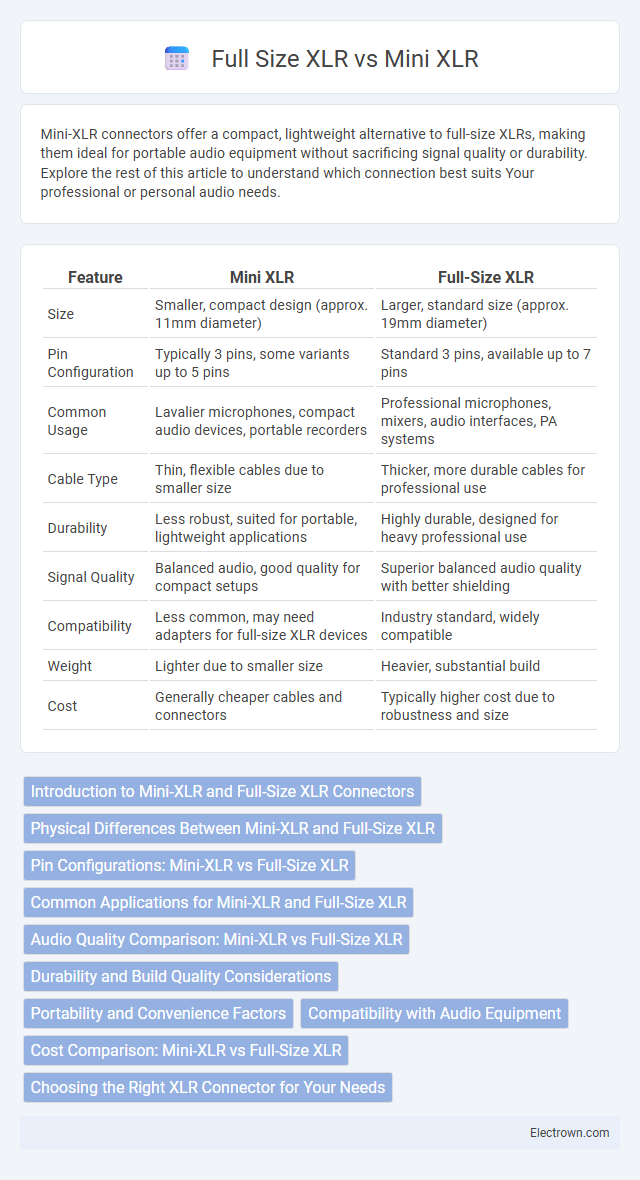Mini-XLR connectors offer a compact, lightweight alternative to full-size XLRs, making them ideal for portable audio equipment without sacrificing signal quality or durability. Explore the rest of this article to understand which connection best suits Your professional or personal audio needs.
Table of Comparison
| Feature | Mini XLR | Full-Size XLR |
|---|---|---|
| Size | Smaller, compact design (approx. 11mm diameter) | Larger, standard size (approx. 19mm diameter) |
| Pin Configuration | Typically 3 pins, some variants up to 5 pins | Standard 3 pins, available up to 7 pins |
| Common Usage | Lavalier microphones, compact audio devices, portable recorders | Professional microphones, mixers, audio interfaces, PA systems |
| Cable Type | Thin, flexible cables due to smaller size | Thicker, more durable cables for professional use |
| Durability | Less robust, suited for portable, lightweight applications | Highly durable, designed for heavy professional use |
| Signal Quality | Balanced audio, good quality for compact setups | Superior balanced audio quality with better shielding |
| Compatibility | Less common, may need adapters for full-size XLR devices | Industry standard, widely compatible |
| Weight | Lighter due to smaller size | Heavier, substantial build |
| Cost | Generally cheaper cables and connectors | Typically higher cost due to robustness and size |
Introduction to Mini-XLR and Full-Size XLR Connectors
Mini-XLR connectors, typically measuring around 14mm in diameter, are compact audio connectors used in professional sound equipment where space-saving is crucial, such as wireless microphones and portable recorders. Full-size XLR connectors, known for their robust build and larger 3-pin design, are industry standards for balanced audio connections in studios and live sound systems. Both types transmit balanced audio signals, reducing noise and interference, but mini-XLRs prioritize portability while full-size XLRs emphasize durability and ease of handling.
Physical Differences Between Mini-XLR and Full-Size XLR
Mini-XLR connectors are notably smaller in size compared to full-size XLR connectors, measuring approximately half the length and diameter, which makes them ideal for compact audio equipment and portable setups. Full-size XLR connectors typically have a robust metal shell and three large pins designed for durability and secure locking in professional audio applications. Your choice between mini-XLR and full-size XLR should consider the physical space available and the connector's compatibility with your audio gear.
Pin Configurations: Mini-XLR vs Full-Size XLR
Mini-XLR connectors typically feature a 3-pin configuration similar to full-size XLRs but are more compact, making them ideal for portable audio equipment. Full-size XLR connectors also have 3 pins with standardized pin assignments (pin 1 for ground, pin 2 for hot, and pin 3 for cold), ensuring balanced audio signals and reduced interference. Understanding these pin configurations helps you select the right connector for reliable and professional audio performance.
Common Applications for Mini-XLR and Full-Size XLR
Mini-XLR connectors are commonly used in portable audio equipment such as lavalier microphones, wireless transmitters, and compact audio recorders due to their smaller size and lightweight design. Full-size XLR connectors dominate professional studio setups, live sound environments, and high-end audio equipment for microphones, mixers, and speakers, offering superior durability and reliable signal integrity. Your choice depends on the balance between portability and durability required for your specific audio application.
Audio Quality Comparison: Mini-XLR vs Full-Size XLR
Mini-XLR connectors deliver audio quality comparable to full-size XLR connectors due to their similar balanced signal transmission and shielding capabilities. Both types maintain low noise interference and high signal integrity, essential for professional audio applications and studio environments. Your choice between mini-XLR and full-size XLR should consider space constraints rather than audio performance, as the sound quality remains consistently high across both formats.
Durability and Build Quality Considerations
Mini-XLR connectors offer compactness and lightweight design but generally have thinner metal housings and smaller pins, making them less rugged than full-size XLR connectors. Full-size XLR connectors feature robust metal construction and thicker pins, providing enhanced durability and resistance to wear in professional audio applications. When choosing your connectors, consider the environment and frequency of use to ensure the build quality meets your durability requirements.
Portability and Convenience Factors
Mini-XLR connectors offer enhanced portability due to their compact size, making them ideal for mobile audio setups and tight spaces where full-size XLR connectors may be cumbersome. Full-size XLR connectors provide greater durability and secure locking mechanisms favored in professional studio and live sound environments but are bulkier and less convenient to carry. Your choice between mini-XLR and full-size XLR depends on balancing the need for convenience and space-saving against durability and cable management preferences.
Compatibility with Audio Equipment
Mini-XLR connectors offer compatibility primarily with compact audio devices such as lavalier microphones, wireless systems, and portable recorders, making them ideal for mobile setups. Full-size XLR connectors are widely used in professional audio equipment including mixers, studio microphones, and sound reinforcement systems, ensuring robust and secure connections. Your choice depends on the specific audio gear you own and the balance between portability and industry-standard compatibility.
Cost Comparison: Mini-XLR vs Full-Size XLR
Mini-XLR connectors generally cost more per unit than full-size XLR connectors due to their compact design and specialized manufacturing process. Full-size XLRs are widely produced and more common in professional audio setups, resulting in lower prices and greater availability. When choosing between the two, budget considerations often favor full-size XLR connectors, especially for large-scale installations or frequent cable replacements.
Choosing the Right XLR Connector for Your Needs
Mini-XLR connectors offer a compact and lightweight solution ideal for portable audio equipment and tight spaces, while full-size XLR connectors provide robust durability and superior shielding for professional studio and live sound environments. Your choice depends on the balance between portability and reliability, with full-size XLRs excelling in secure connections and noise reduction, and mini-XLRs prioritizing convenience without sacrificing audio quality. Consider your setup's size constraints, durability requirements, and the level of signal integrity needed to select the right XLR connector for your needs.
mini-xlr vs full size xlr Infographic

 electrown.com
electrown.com